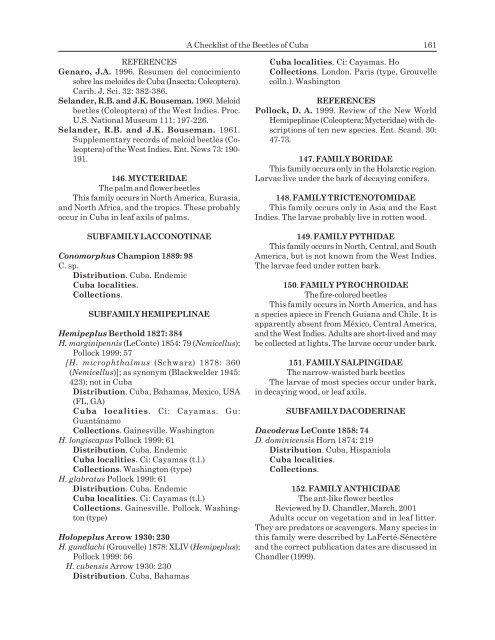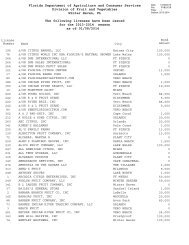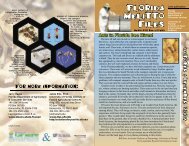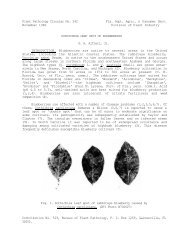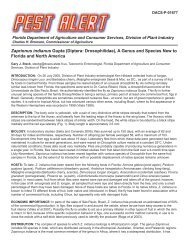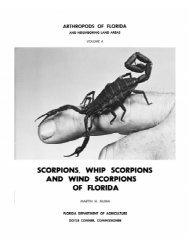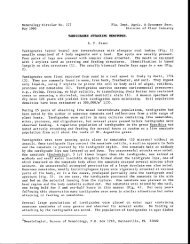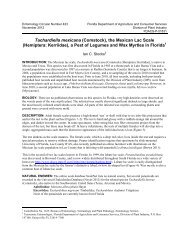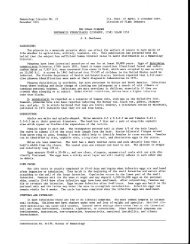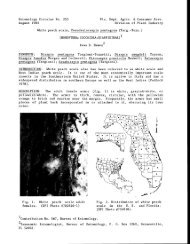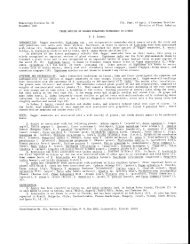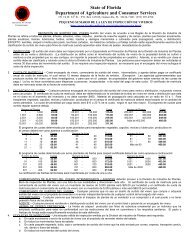A Checklist of the Beetles of Cuba with Data on Distributions and ...
A Checklist of the Beetles of Cuba with Data on Distributions and ...
A Checklist of the Beetles of Cuba with Data on Distributions and ...
You also want an ePaper? Increase the reach of your titles
YUMPU automatically turns print PDFs into web optimized ePapers that Google loves.
REFERENCES<br />
Genaro, J.A. 1996. Resumen del c<strong>on</strong>ocimiento<br />
sobre las meloides de <str<strong>on</strong>g>Cuba</str<strong>on</strong>g> (Insecta: Coleoptera).<br />
Carib. J. Sci. 32: 382-386.<br />
Sel<strong>and</strong>er, R.B. <strong>and</strong> J.K. Bouseman. 1960. Meloid<br />
beetles (Coleoptera) <str<strong>on</strong>g>of</str<strong>on</strong>g> <str<strong>on</strong>g>the</str<strong>on</strong>g> West Indies. Proc.<br />
U.S. Nati<strong>on</strong>al Museum 111: 197-226.<br />
Sel<strong>and</strong>er, R.B. <strong>and</strong> J.K. Bouseman. 1961.<br />
Supplementary records <str<strong>on</strong>g>of</str<strong>on</strong>g> meloid beetles (Coleoptera)<br />
<str<strong>on</strong>g>of</str<strong>on</strong>g> <str<strong>on</strong>g>the</str<strong>on</strong>g> West Indies. Ent. News 73: 190-<br />
191.<br />
146. MYCTERIDAE<br />
The palm <strong>and</strong> flower beetles<br />
This family occurs in North America, Eurasia,<br />
<strong>and</strong> North Africa, <strong>and</strong> <str<strong>on</strong>g>the</str<strong>on</strong>g> tropics. These probably<br />
occur in <str<strong>on</strong>g>Cuba</str<strong>on</strong>g> in leaf axils <str<strong>on</strong>g>of</str<strong>on</strong>g> palms.<br />
SUBFAMILY LACCONOTINAE<br />
C<strong>on</strong>omorphus Champi<strong>on</strong> 1889: 98<br />
C. sp.<br />
Distributi<strong>on</strong>. <str<strong>on</strong>g>Cuba</str<strong>on</strong>g>. Endemic<br />
<str<strong>on</strong>g>Cuba</str<strong>on</strong>g> localities.<br />
Collecti<strong>on</strong>s.<br />
SUBFAMILY HEMIPEPLINAE<br />
Hemipeplus Berthold 1827: 384<br />
H. marginipennis (LeC<strong>on</strong>te) 1854: 79 (Nemicellus);<br />
Pollock 1999: 57<br />
[H. microphthalmus (Schwarz) 1878: 360<br />
(Nemicellus)]; as syn<strong>on</strong>ym (Blackwelder 1945:<br />
423); not in <str<strong>on</strong>g>Cuba</str<strong>on</strong>g><br />
Distributi<strong>on</strong>. <str<strong>on</strong>g>Cuba</str<strong>on</strong>g>, Bahamas, Mexico, USA<br />
(FL, GA)<br />
<str<strong>on</strong>g>Cuba</str<strong>on</strong>g> localities. Ci: Cayamas. Gu:<br />
Guantánamo<br />
Collecti<strong>on</strong>s. Gainesville. Washingt<strong>on</strong><br />
H. l<strong>on</strong>giscapus Pollock 1999: 61<br />
Distributi<strong>on</strong>. <str<strong>on</strong>g>Cuba</str<strong>on</strong>g>. Endemic<br />
<str<strong>on</strong>g>Cuba</str<strong>on</strong>g> localities. Ci: Cayamas (t.l.)<br />
Collecti<strong>on</strong>s. Washingt<strong>on</strong> (type)<br />
H. glabratus Pollock 1999: 61<br />
Distributi<strong>on</strong>. <str<strong>on</strong>g>Cuba</str<strong>on</strong>g>. Endemic<br />
<str<strong>on</strong>g>Cuba</str<strong>on</strong>g> localities. Ci: Cayamas (t.l.)<br />
Collecti<strong>on</strong>s. Gainesville. Pollock. Washingt<strong>on</strong><br />
(type)<br />
Holopeplus Arrow 1930: 230<br />
H. gundlachi (Grouvelle) 1878: XLIV (Hemipeplus);<br />
Pollock 1999: 56<br />
H. cubensis Arrow 1930: 230<br />
Distributi<strong>on</strong>. <str<strong>on</strong>g>Cuba</str<strong>on</strong>g>, Bahamas<br />
A <str<strong>on</strong>g>Checklist</str<strong>on</strong>g> <str<strong>on</strong>g>of</str<strong>on</strong>g> <str<strong>on</strong>g>the</str<strong>on</strong>g> <str<strong>on</strong>g>Beetles</str<strong>on</strong>g> <str<strong>on</strong>g>of</str<strong>on</strong>g> <str<strong>on</strong>g>Cuba</str<strong>on</strong>g> 161<br />
<str<strong>on</strong>g>Cuba</str<strong>on</strong>g> localities. Ci: Cayamas. Ho<br />
Collecti<strong>on</strong>s. L<strong>on</strong>d<strong>on</strong>. Paris (type, Grouvelle<br />
colln.). Washingt<strong>on</strong><br />
REFERENCES<br />
Pollock, D. A. 1999. Review <str<strong>on</strong>g>of</str<strong>on</strong>g> <str<strong>on</strong>g>the</str<strong>on</strong>g> New World<br />
Hemipeplinae (Coleoptera: Mycteridae) <str<strong>on</strong>g>with</str<strong>on</strong>g> descripti<strong>on</strong>s<br />
<str<strong>on</strong>g>of</str<strong>on</strong>g> ten new species. Ent. Sc<strong>and</strong>. 30:<br />
47-73.<br />
147. FAMILY BORIDAE<br />
This family occurs <strong>on</strong>ly in <str<strong>on</strong>g>the</str<strong>on</strong>g> Holarctic regi<strong>on</strong>.<br />
Larvae live under <str<strong>on</strong>g>the</str<strong>on</strong>g> bark <str<strong>on</strong>g>of</str<strong>on</strong>g> decaying c<strong>on</strong>ifers.<br />
148. FAMILY TRICTENOTOMIDAE<br />
This family occurs <strong>on</strong>ly in Asia <strong>and</strong> <str<strong>on</strong>g>the</str<strong>on</strong>g> East<br />
Indies. The larvae probably live in rotten wood.<br />
149. FAMILY PYTHIDAE<br />
This family occurs in North, Central, <strong>and</strong> South<br />
America, but is not known from <str<strong>on</strong>g>the</str<strong>on</strong>g> West Indies.<br />
The larvae feed under rotten bark.<br />
150. FAMILY PYROCHROIDAE<br />
The fire-colored beetles<br />
This family occurs in North America, <strong>and</strong> has<br />
a species apiece in French Guiana <strong>and</strong> Chile. It is<br />
apparently absent from México, Central America,<br />
<strong>and</strong> <str<strong>on</strong>g>the</str<strong>on</strong>g> West Indies. Adults are short-lived <strong>and</strong> may<br />
be collected at lights. The larvae occur under bark.<br />
151. FAMILY SALPINGIDAE<br />
The narrow-waisted bark beetles<br />
The larvae <str<strong>on</strong>g>of</str<strong>on</strong>g> most species occur under bark,<br />
in decaying wood, or leaf axils.<br />
SUBFAMILY DACODERINAE<br />
Dacoderus LeC<strong>on</strong>te 1858: 74<br />
D. dominicensis Horn 1874: 219<br />
Distributi<strong>on</strong>. <str<strong>on</strong>g>Cuba</str<strong>on</strong>g>, Hispaniola<br />
<str<strong>on</strong>g>Cuba</str<strong>on</strong>g> localities.<br />
Collecti<strong>on</strong>s.<br />
152. FAMILY ANTHICIDAE<br />
The ant-like flower beetles<br />
Reviewed by D. Ch<strong>and</strong>ler, March, 2001<br />
Adults occur <strong>on</strong> vegetati<strong>on</strong> <strong>and</strong> in leaf litter.<br />
They are predators or scavengers. Many species in<br />
this family were described by LaFerté-Sénectère<br />
<strong>and</strong> <str<strong>on</strong>g>the</str<strong>on</strong>g> correct publicati<strong>on</strong> dates are discussed in<br />
Ch<strong>and</strong>ler (1999).


